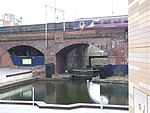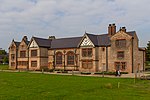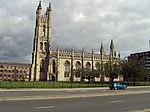Cornbrook railway station
Disused railway stations in TraffordFormer Manchester, South Junction and Altrincham Railway stationsPages with no open date in Infobox stationRailway stations in Great Britain closed in 1865Railway stations in Great Britain opened in 1856 ... and 1 more
Use British English from March 2018
Cornbrook railway station was opened on the south side of Cornbrook Road in the St. George's area of Manchester on 12 May 1856 by the Manchester South Junction and Altrincham Railway (MSJAR) to serve the nearby Pomona Gardens; there were four trains daily in each direction. It closed on 1 June 1865, the last trains having called on 31 May 1865.
Excerpt from the Wikipedia article Cornbrook railway station (License: CC BY-SA 3.0, Authors).Cornbrook railway station
Cornbrook Road, Trafford Old Trafford
Geographical coordinates (GPS) Address External links Nearby Places Show on map
Geographical coordinates (GPS)
| Latitude | Longitude |
|---|---|
| N 53.4693 ° | E -2.2686 ° |
Address
Cornbrook
Cornbrook Road
M15 4WD Trafford, Old Trafford
England, United Kingdom
Open on Google Maps









